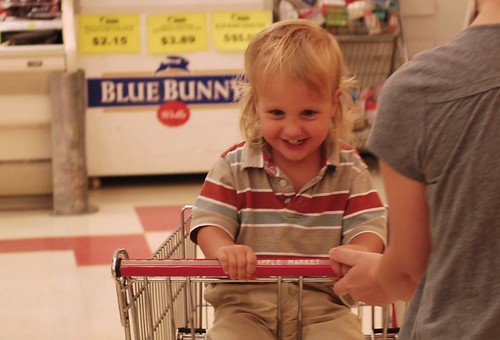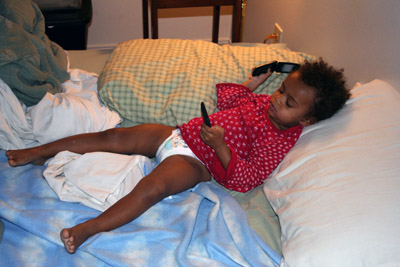This post is the fourth in a series about gentle parenting through potential power struggles with your toddler or preschooler. Each post will give you ideas and examples for using love, patience, and creativity to work through some fairly common parent/toddler areas of concern: brushing teeth, getting into the car seat, meals/eating, grocery shopping, diaper changes, and picking up toys. I welcome your gentle/respectful parenting ideas and feedback.
_______________

Ideas to Make Shopping a Positive Experience
Give Your Toddler Input: involve your toddler when you are creating your shopping list. Talk about the fruits, vegetables, grains, etc. you will need to make meals for the next few days. Let them decide what vegetables (or whatever) they want to eat. Use it as an opportunity to talk about healthy foods. If you don’t have time (or your toddler doesn’t have the desire) to plan ahead, let them make a few healthy choices at the store (or take them to a farmer’s market, where almost everything is healthy!).
Try Stickers: if your little one is dexterous enough to peel stickers off of a sheet, set them up with room to peel and stick onto a grocery store ad. You could make it similar to a game of BINGO – put a sticker on every item from the ad that you pass.
Scavenger Hunts and Treasure Maps: cut out pictures from the ad and hand them out – see who can help you find their items. If you really want to get fancy, you could make a map of your regular grocery store and laminate it. Then you could use a dry erase marker to write the items you need on the map for each shopping trip. Your toddler can help you find them using her “treasure map.”
Play the Quiet/Tiptoe Game: make a game out of who can use sign language/pantomime to communicate, who can whisper the longest, or who can walk on their tiptoes the longest.
Don’t Buy That!: one time when Kieran was in perpetual whiny “I want” mode, I started joking with him by saying “I do NOT want to buy that!” “Ew, let’s not buy that!” Soon he was giggling and playing along, pointing at different items and saying “don’t buy that mama!” We’ve played this game almost every shopping visit since then. I’d like to incorporate something about healthy choices into the game: “don’t buy chips, they aren’t healthy!”
Let Them Help: trust your toddler with certain responsibilities: putting items in the cart (model for them how to do it gently, but remember they probably will never be quite as gentle as you are), finding and putting fruit/vegetables in bags, holding the shopping list (use the opportunity to talk about letters if you’d like), etc.
Play I Spy: take turns “spying” different colors (“I spy something blue”), different materials (“I spy something made out of paper”), items for different rooms of the house (“I spy something that belongs in the bathroom”), and more.

Take Snacks: have you ever noticed that toddlers want whatever they see? Going into a grocery store without something to snack on can be a disaster waiting to happen. I try not to use food as a hush tactic or bribe, but in a grocery store it is almost necessary (for Kieran, anyway). A bag of trail mix or dried fruit can occupy little fingers for quite awhile.
Set Them Up for Success: what’s better – a rested toddler with food in her tummy at a relatively calm grocery store, or a tired and hungry toddler bewildered by the chaos during a store’s rush hour? When possible, set your toddler up for a successful shopping trip by going when your toddler and the store are at their best. For Kieran, that means I don’t shop when he’s tired (whining rapidly transitions into crying); and we always try to hit Costco when they have samples out (ha).
Play “What Doesn’t Belong”: if you have a short shopping list, talk to your child in advance about what you will be getting. Then grab one extra item that is not on your list. Help your toddler figure out which item does not belong in the cart before you put it on the counter.
Make It an Adventure: take your kids on a tropical (or safari or deep space) adventure. This works especially well when it’s time to leave the store and the toddler is resisting. For example, Kieran sometimes wants to hide under clothing racks when it’s time to go. Several times he has willingly (eagerly even) come with me when I say in an excited voice “Kieran, let’s go on a journey together! We have a long way to walk to the car, and I need your help chasing away the lions!”
Wear a Carrier: If you are able to wear your toddler, bring a carrier to the store with you. Lots of kiddos are content on a parent’s back where they wouldn’t be content in a shopping cart (I know! Kieran is one of them). If you thought babywearing was just for infants, think again! We love our ABC Carrier and our Ergo – at 31 lbs Kieran is still comfortable in a front or back carry, and he loves to go for a ride.
Shop Fast: when all else fails, don’t prolong the agony for yourself or your kids. Get in, get out, and get on with your day.
What ideas do you have to help make shopping a good experience? Please share them in the comments.
________________________
This post has been edited from a previous version published at Code Name: Mama.
![]() Check out these new articles on The Attached Family online magazine, www.theattachedfamily.com:
Check out these new articles on The Attached Family online magazine, www.theattachedfamily.com:




